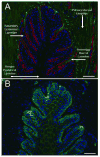Distribution and processing of a disintegrin and metalloproteinase with thrombospondin motifs-4, aggrecan, versican, and hyaluronan in equine digital laminae
- PMID: 22738056
- PMCID: PMC3535468
- DOI: 10.2460/ajvr.73.7.1035
Distribution and processing of a disintegrin and metalloproteinase with thrombospondin motifs-4, aggrecan, versican, and hyaluronan in equine digital laminae
Abstract
Objective: To determine the expression and distribution of a disintegrin and metalloproteinase with thrombospondin motifs-4 (ADAMTS-4), its substrates aggrecan and versican, and their binding partner hyaluronan in laminae of healthy horses.
Sample: Laminae from the forelimb hooves of 8 healthy horses.
Procedures: Real-time quantitative PCR assay was used for gene expression analysis. Hyaluronidase, chondroitinase, and keratanase digestion of lamina extracts combined with SDS-PAGE and western blotting were used for protein and proteoglycan analysis. Immunofluorescent and immunohistochemical staining of tissue sections were used for protein and hyaluronan localization.
Results: Genes encoding ADAMTS-4, aggrecan, versican, and hyaluronan synthase II were expressed in laminae. The ADAMTS-4 was predominantly evident as a 51-kDa protein bearing a catalytic site neoepitope indicative of active enzyme and in situ activity, which was confirmed by the presence of aggrecan and versican fragments bearing ADAMTS-4 cleavage neoepitopes in laminar protein extracts. Aggrecan, versican, and hyaluronan were localized to basal epithelial cells within the secondary epidermal laminae. The ADAMTS-4 localized to these cells but was also present in some cells in the dermal laminae.
Conclusions and clinical relevance: Within digital laminae, versican exclusively and aggrecan primarily localized within basal epithelial cells and both were constitutively cleaved by ADAMTS-4, which therefore contributed to their turnover. On the basis of known properties of these proteoglycans, it is possible that they can protect the basal epithelial cells of horses from biomechanical and concussive stress.
Figures








Similar articles
-
Effects of cleavage by a disintegrin and metalloproteinase with thrombospondin motifs-4 on gene expression and protein content of versican and aggrecan in the digital laminae of horses with starch gruel-induced laminitis.Am J Vet Res. 2012 Jul;73(7):1047-56. doi: 10.2460/ajvr.73.7.1047. Am J Vet Res. 2012. PMID: 22738057 Free PMC article.
-
Regulation of aggrecanases from the ADAMTS family and aggrecan neoepitope formation during in vitro chondrogenesis of human mesenchymal stem cells.Eur Cell Mater. 2012 May 4;23:320-32. doi: 10.22203/ecm.v023a25. Eur Cell Mater. 2012. PMID: 22562232
-
ADAMTS4 and ADAMTS5 knockout mice are protected from versican but not aggrecan or brevican proteolysis during spinal cord injury.Biomed Res Int. 2014;2014:693746. doi: 10.1155/2014/693746. Epub 2014 Jul 3. Biomed Res Int. 2014. PMID: 25101296 Free PMC article.
-
[Research progress of a disintegrin and metalloproteinase with thrombospondin motif 4 and 5 in osteoarthritis].Zhongguo Xiu Fu Chong Jian Wai Ke Za Zhi. 2013 Sep;27(9):1080-4. Zhongguo Xiu Fu Chong Jian Wai Ke Za Zhi. 2013. PMID: 24279019 Review. Chinese.
-
Aggrecanase and aggrecan degradation in osteoarthritis: a review.J Int Med Res. 2008 Nov-Dec;36(6):1149-60. doi: 10.1177/147323000803600601. J Int Med Res. 2008. PMID: 19094423 Review.
Cited by
-
Effects of cleavage by a disintegrin and metalloproteinase with thrombospondin motifs-4 on gene expression and protein content of versican and aggrecan in the digital laminae of horses with starch gruel-induced laminitis.Am J Vet Res. 2012 Jul;73(7):1047-56. doi: 10.2460/ajvr.73.7.1047. Am J Vet Res. 2012. PMID: 22738057 Free PMC article.
-
Expression and activity of collagenases in the digital laminae of horses with carbohydrate overload-induced acute laminitis.J Vet Intern Med. 2014 Jan-Feb;28(1):215-22. doi: 10.1111/jvim.12252. Epub 2013 Nov 25. J Vet Intern Med. 2014. PMID: 24479657 Free PMC article.
-
Pooled Platelet-Rich Plasma Lysate Therapy Increases Synoviocyte Proliferation and Hyaluronic Acid Production While Protecting Chondrocytes From Synoviocyte-Derived Inflammatory Mediators.Front Vet Sci. 2018 Jul 4;5:150. doi: 10.3389/fvets.2018.00150. eCollection 2018. Front Vet Sci. 2018. PMID: 30023361 Free PMC article.
-
Short-Term Exposure to Ciprofloxacin Reduces Proteoglycan Loss in Tendon Explants.Genes (Basel). 2022 Nov 25;13(12):2210. doi: 10.3390/genes13122210. Genes (Basel). 2022. PMID: 36553476 Free PMC article.
-
Use of laser capture microdissection for the assessment of equine lamellar basal epithelial cell signalling in the early stages of laminitis.Equine Vet J. 2015 Jul;47(4):478-88. doi: 10.1111/evj.12283. Epub 2014 Aug 19. Equine Vet J. 2015. PMID: 24750316 Free PMC article.
References
-
- Pollitt CC. The Anatomy and Physiology of the Suspensory Apparatus of the Distal Phalanx. Veterinary Clinics of North America: Equine Practice. 2010;26:29–49. Advances in Laminitis, Part I. - PubMed
-
- French KR, Pollitt CC. Equine laminitis: loss of hemidesmosomes in hoof secondary epidermal lamellae correlates to dose in an oligofructose induction model: an ultrastructural study. Equine Vet J. 2004;36:230–235. - PubMed
-
- Black SJ. Extracellular matrix, leukocyte migration and laminitis. Vet Immunol Immunopathol. 2009;129:161–163. - PubMed
-
- Budras KD, Hullinger RL, Sack WO. Light and electron microscopy of keratinization in the laminar epidermis of the equine hoof with reference to laminitis. Am J Vet Res. 1989;50:1150–1160. - PubMed
Publication types
MeSH terms
Substances
Grants and funding
LinkOut - more resources
Full Text Sources

